|
|
|
|
Coils, electromagnetic field.
|
 translation French/ English : sens= direction, bobine=coil, courant=current
translation French/ English : sens= direction, bobine=coil, courant=current
Solenoid:
it is a succession of electrical windings (turns).The real coil below is an example and we can see, in yellow, the beginning of a winding (one turn). The number of turns and layers can be
very large (for example, 300 revolutions per cm length).
Any coil powered by an alternating current creates alternating opposite magnetic poles + then - that are changing of
polarity ( - then + ) etc.
|
 This coil carrying an electric current creates a strong electric field that will get the iron rod "swallowed" in his hole, presented here completely
removed to clarify the explanation. With a current direction according to red arrow, the North pole of the coil is created by the magnetic flux directed as
the large white arrow.
This coil carrying an electric current creates a strong electric field that will get the iron rod "swallowed" in his hole, presented here completely
removed to clarify the explanation. With a current direction according to red arrow, the North pole of the coil is created by the magnetic flux directed as
the large white arrow.
This created pole N induces a pole south in the close iron rod ("the" s "white),
There are no magnetic poles in a closed magnetic circuit,
but a continuous oriented field that can be used in the vacuum center.
|
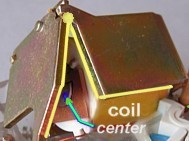
- Air Gap. It is an air space in a magnetic circuit that creates two opposite poles, and consequently an magnetic airf field, as a horseshoe magnet.
This contactor is composed of a magnetic coil (yellowish "bobine") with its central round
iron bar (noyau).
The coil is surrounded by a metallic circuit open by a an hinged piece; an air gap, |
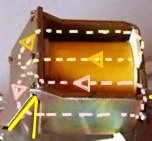 Magnetic circuit.
This is usually the piece of metal or equivalent permeable to the flux, it
captures and contains the magnetic flux rather than the surrounding air
Magnetic circuit.
This is usually the piece of metal or equivalent permeable to the flux, it
captures and contains the magnetic flux rather than the surrounding air
A coil of wire is usually wrapped around by metallic pieces (converter, electro-magnets, inductors, etc.) This gap must be reduce because the magnetic fields that fancy for escapades in the open air. Above contactors are used to switch on and off a remote circuit that need short high diameter cupper wire : it is the one you shut when turning the ignition key of your car, by a thin wire remote control. This contactor put then the power on the electric starter gear. |
Engines and generators have revolutionized the society (lighting, industrial, domestic) but also the
measuring devices, contactors, circuit breakers, electromagnetic relays (factories, power plants, power supply cabinets, previous
generations of automatic telephony, servomechanisms, transformers.
The phone headset, speakerphone and radio HI FI; the atria of our players and MP3 players are always based on the principle of the
electromagnet which makes vibrate a membrane. There were timers in staircase : a pendulum was launched by a rod "sucked" in the coil of an
electromagnet when pressing the button, then swaying a few minutes; light extinction coming at its stopping.
The telephone ring or station ring stem also from the electromagnet, as gongs and chimes door did.
Switches for railways, Industrial trucks and high speed trains with linear motor (Germany, Japan); capture (petanque balls, screws, needles on the ground, steel particles in oil car),
sorting industrial metals (I know a who has always him on a small magnet on his door keys); cranes for clutching scrap metal, industrial machinery, closing control lock, remote control
for model aircraft or car doors locking, and in the field of ultra precision electronics, a whole generation of cassette players, CD and DVD; disk
drives, video recorders. Let us not forget the scientific field (EMF) and medical too (magnetic resonance imaging (MRI). These are just a few examples.
If the principle of current production is simple, everything is unfortunately complicated in the wires arrangement that is knitting mesh ; that is for different reasons, learned from experience and calculs. It is particularly important that each driver bath in the flux producted between each pole inductor, and no other parts of the wire cable are induced by a reverse currents, they are to the fight against noisy currents induced, fight against distortion fields generated by magnetic fields opposed by the wires "induced" themselves.
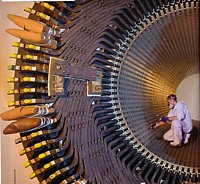 Giant alternator driven by hydraulic turbines. Here the "armature"
(inductive), which produces the electricity under the effect of a "scanning" magnetic fields produced by the rotor (inductor).
Giant alternator driven by hydraulic turbines. Here the "armature"
(inductive), which produces the electricity under the effect of a "scanning" magnetic fields produced by the rotor (inductor).
Note:
theses view are distorted by perspectives
 The rotor (inductor) rotates inside the armature. Composed of magnetic poles) (solenoids), it must be supplied with electricity.
The rotor then emits electric fields that rotate with it, sweeping the wires of the armature.
The rotor (inductor) rotates inside the armature. Composed of magnetic poles) (solenoids), it must be supplied with electricity.
The rotor then emits electric fields that rotate with it, sweeping the wires of the armature.
The static part around the rotor core, generally said armature (inductive), is which that produces the current.
The current is "induced"
because its copper wires are swept by the magnetic fields of the rotor,
said inductor, which is spinning inside. We can see here the ends of
copper wires that look like much more rods than usual wires.
Everything is huge here : of which 160 kilometers of copper rods perfectly arranged and firmly bond.

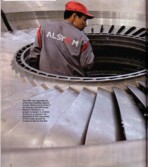 right,hand a turbine for the Vietnam
right,hand a turbine for the Vietnam
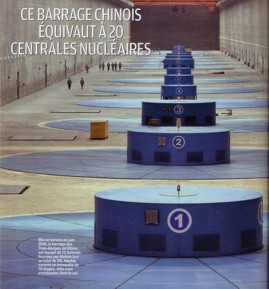 Hall of hydraulic turbines and generators of the Three Gorges Dam (China).
15 out of 26 are produced by Alsthom. Embedded in the dam, a whole unit is as tall as a building of 10 storeys. and meters
21 in diameter. At the bottom of each well is placed a water turbine (with wings), which is operated by the torrent of water
from the dam. Above its axis make spinning the alternator rotor, surrounded by its armature (see left for armatures and inductors).
Hall of hydraulic turbines and generators of the Three Gorges Dam (China).
15 out of 26 are produced by Alsthom. Embedded in the dam, a whole unit is as tall as a building of 10 storeys. and meters
21 in diameter. At the bottom of each well is placed a water turbine (with wings), which is operated by the torrent of water
from the dam. Above its axis make spinning the alternator rotor, surrounded by its armature (see left for armatures and inductors).
Unfortunately, half are only running (February 2010) due to the shortage of water in the Yangzi !
and some problems arose also for the bank.
|
|